Easy Vegetable Tempura Recipe
Updated: 08 Jun 2023
284
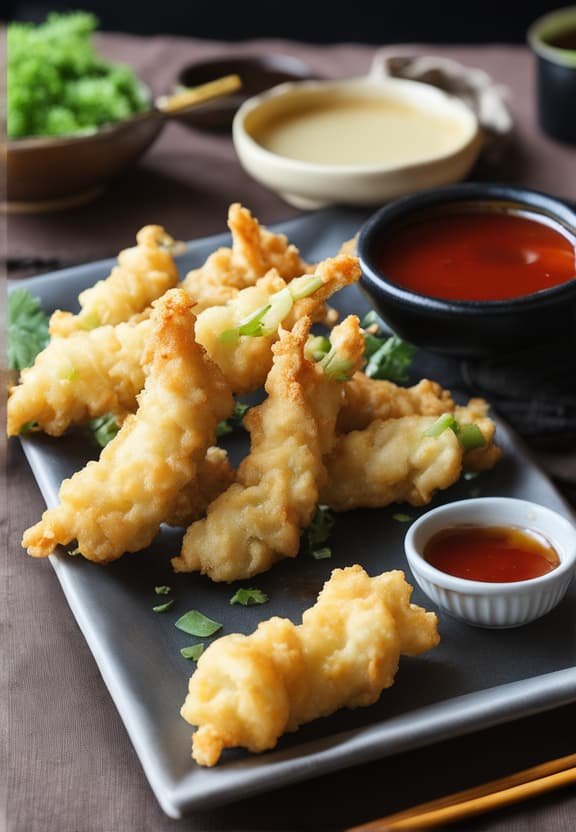
Get ready to give boring vegetables an ultra-crispy Japanese makeover!
Tempura Vegetable takes veggie sides from snoring to score by coating them in a featherlight batter before frying. This crave-worthy cooking technique adds some crunch and golden color without masking the natural flavors within.
This fun tempura vegetable recipe will demystify the secrets behind making the magical tempura batter from scratch. You’ll learn how to finely chop and mix an assortment of fresh vegetables like broccoli, carrots, mushrooms, and green beans to prepare them for frying. Then it’s into the hot oil, where they go for a quick crisping up.
Table of Contents
What is Tempura?
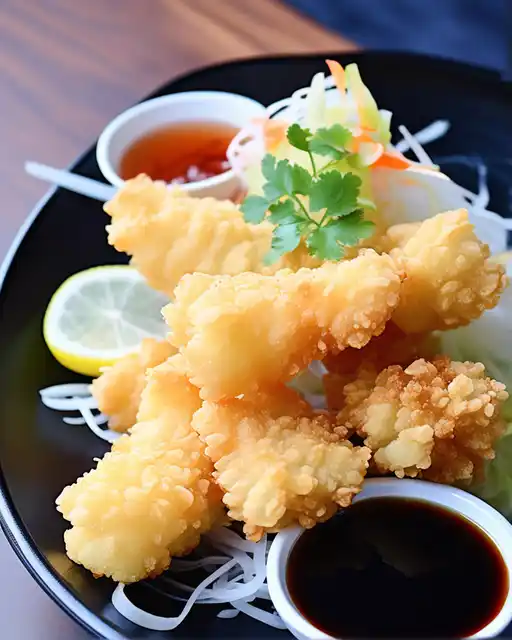
Tempura is a popular Japanese dish made by dipping vegetables, seafood, or meat into a very light batter and then quickly frying it. When cooked properly, tempura comes out with a light, crispy coating surrounding the ingredients inside. It is often served with a dipping sauce and enjoyed as an appetizer, side dish, or entree.
Tempura’s Origins
Did you know that Portuguese traders introduced deep-frying to Japan in the 16th century, and many believe that this marked the beginning of tempura’s origins?
Initially, they called it “Peixinhos da Horta,” which translates to “little fish from the garden” in Portuguese. Over time, Japanese people adapted this dish and made it their own by adding local ingredients and culinary techniques.
Why Tempura is Great for Vegetables
- Tempura batter is light and crispy, adding crunch and flavor to vegetables without overpowering their natural taste.
- The quick frying method cooks vegetables fast while keeping them tender inside.
- You can use tempura batter to add interest and variety to typically boring veggies like broccoli, carrots, cauliflower, etc.
- Both kids and adults enjoy the flavor and texture tempura adds to vegetables.
- Tempura vegetables make easy, fun finger food for get-togethers and parties.
- From green beans to sweet potatoes, the tempura method works with all kinds of vegetables.
- Eating more vegetables is healthy, and tempura makes them more fun and appealing.
- Dipping tempura vegetables in flavorful sauces adds an extra kick of taste.
- Tempura’s crunch makes vegetables more dynamic in texture compared to steaming or boiling.
- Cooking vegetables in tempura batter allows you to add your favorite seasonings to the mix.
How to Make Tempura for Vegetables
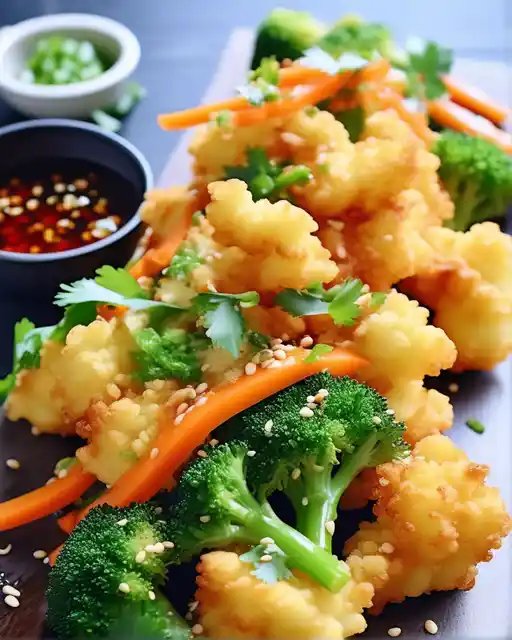
- Decide which tender, hardy vegetables would be best for tempura like broccoli, carrots, onion, mushrooms, etc.
- Slice the cleaned vegetables into small, uniform pieces for easy frying.
- Make the tempura batter by mixing cold soda water, flour, cornstarch, and egg.
- The batter should be light and thin enough to coat vegetables without clumping.
- Heat at least 2 inches depth of oil to 350°F in a heavy pot or pan for frying.
- Dip a few vegetable pieces at a time in the tempura batter to lightly coat.
- Gently drop the coated vegetables into the hot oil and fry for 2-3 minutes.
- Use a slotted spoon to transfer the fried tempura vegetables to a paper towel.
- Sprinkle with salt lightly while hot or dip in a flavorful sauce like soy sauce.
- Keep finished tempura vegetables warm in a low oven if frying multiple batches.
- Adjust batter thickness if needed and let oil return to 350°F between frying.
- Try different dipping sauces like ranch, sweet chili sauce, honey mustard or curry mayo
Preparing Vegetables for Perfect Tempura
- Choose tender, low-moisture vegetables like zucchini, sweet potatoes, carrots, beans, mushrooms, etc.
- Wash vegetables thoroughly and make sure they are scorched before coating.
- Cut vegetables into uniformly thin slices or sticks to ensure quick, even cooking.
- Get vegetable pieces as dry as possible by gently blotting them with paper towels.
- Let some veggie slices like eggplant or zucchini sweat out moisture with salt.
- Use cornstarch, potato starch, or flour to lightly coat vegetables before batter.
- This coating helps the thin tempura batter stick without slipping off.
- Make sure the oil is at the right temperature, around 350-375°F to fry properly.
- Do not overcrowd the pot when frying in small batches for best results.
- Mix up light and crispy tempura batter that thinly coats vegetables.
- Use chopsticks or tongs to gently add a few pieces of veggies at a time to oil.
- Fry for 30 seconds up to 2 minutes until the coating is golden and crisp, not brown.
- Remove tempura with a slotted spoon and let excess oil drip off.
- Sprinkle with salt right after frying or enjoy dipping sauces on the side
Vegetable Tempura Recipe
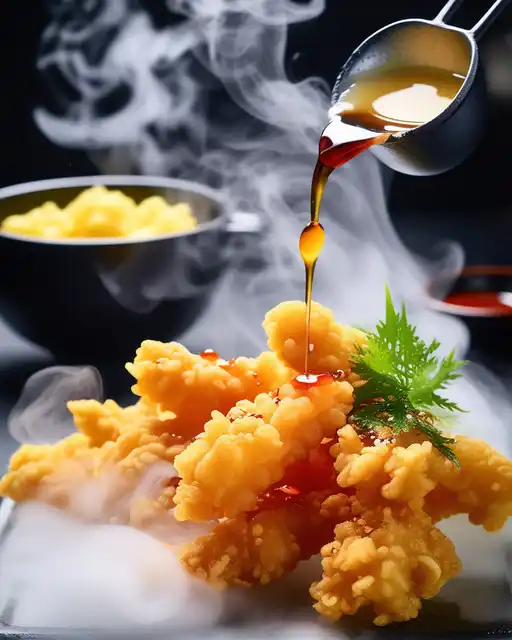
Making tempura for vegetables is surprisingly easy, but it does require a few key ingredients and techniques to ensure success. Here’s what you’ll need to get started:
Tempura Vegetables Ingredients:
- 1 cup ice-cold sparkling water
- 1 large farm-fresh egg
- 1 1⁄4 cups all-purpose flour
- 3 Tbsp cornstarch
- 2 tsp baking powder
- 1⁄2 tsp salt
- 1 cup vegetables cut into thin strips or cubes (carrots, broccoli, cabbage, onion, zucchini, sweet potatoes – select crispy veggies with lower moisture)
- Oil for frying (peanut, vegetable, canola, or rice bran oil) – 2 cups
- Salt, pepper, lemon wedges, or dipping sauce for serving
Instructions
1. Gather Ingredients
- Assemble cold sparkling water, flour, cornstarch, baking powder, salt, egg, vegetables, and frying oil.
2. Prepare the Ingredients
- Wash, dry, and slice vegetables like zucchini, broccoli, and carrots, into uniform thin pieces.
- Pat vegetable pieces very dry with paper towels.
3. Make the Batter
- In a mixing bowl, beat an egg till blended smooth.
- Add the flour, cornstarch, baking powder, and salt.
- Slowly pour in cold soda water while mixing constantly, avoid lumps.
- Mix just until combined but still slightly lumpy for a light texture.
4. Heat the Oil
- Pour at least 2 inches of frying oil into a heavy pot and heat to 375°F.
- Use a deep fry or candy thermometer to monitor the temperature.
5. Fry the Vegetables
- Dip a few vegetable pieces at a time into the batter to lightly coat.
- Gently drop into hot oil without overcrowding the pot.
- Fry for 2-3 minutes, turning over halfway if needed.
- Remove golden brown crispy tempura with a slotted spoon.
6. Finish and Serve
- Drain fried tempura vegetables on a paper towel-lined plate.
- Sprinkle with salt while hot or serve with dipping sauce.
The Magic of the Tempura Cooking Technique
- Tempura uses a super thin, lumpy batter that fries up magically light and crispy.
- The batter works its magic by trapping steam and air bubbles as the tempura fries.
- This allows the vegetable inside to steam cook, becoming tender while the batter fries up delicate and crunchy.
- Frying at the right high heat of 350-375°F makes the tempura batter set and crystallize instantly.
- The fast frying ensures vegetables cook yet remain wonderfully juicy inside.
- Less popular vegetables become magical when tempura is battered like cauliflower, green beans, and parsnips.
- The tempura batter recipe itself has magical ingredients like soda water, cake flour, and egg that create its delicate crunch.
- Store-bought tempura batters can’t match the magic texture of homemade with the right simple ingredients.
- Part of the magical appeal of tempura is how suddenly yet beautifully it fries up from liquid batter to golden crust.
- Dipping piping hot freshly fried tempura batter into magical sweet and sour sauces completes the magical experience
Serving Up Delicious Vegetable Tempura
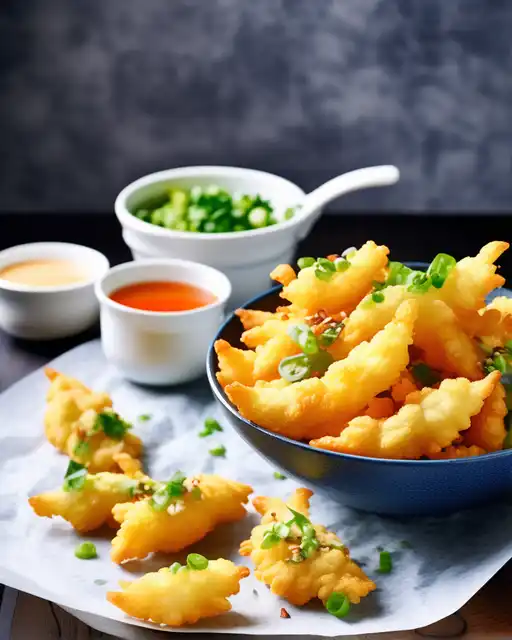
- Serve with classic dipping sauces like tempura dipping sauce, tonkatsu sauce, soy sauce, or ponzu sauce.
- Garnish with sesame seeds, shichimi togarashi, or lemon wedges.
- Try lighter dipping options like ranch, honey mustard, or garlic mayo.
- Stack tempura vegetables over rice or greens for a meal.
- Toss them into salads or bowls for an extra crisp texture.
Creative Ways to Vary Your Vegetable Tempura
- Coat with potato or cornstarch before battering for ultra crispiness.
- Use flavored sparkling waters like lemon-lime or ginger ale for the batter liquid.
- Mix spices or herbs into the batter like chili powder, rosemary, paprika, or cayenne.
- Play with different dipping sauces like sweet chili sauce, vinegar hot sauce, teriyaki, etc.
- Swap the classic flour batter for a flaky cornmeal or coconut flour version.
- Stuff thicker vegetables like mushrooms or zucchini with cheese before battering.
- Pair with seafood like fried shrimp or calamari for delicious veggie combinations
The best Vegetables for Tempura
Here are some of the best vegetables to use for tempura:
1. Sweet Potatoes
Their natural sweetness balances beautifully with the light tempura batter. Sweet potato tempura is a classic for a reason!
2. Asparagus
The stalks cook up with a pleasing, crisp-tender texture. Dip the tips in tempura batter for finger food fun.
3. Green Beans
Long, slender green beans offer a satisfying crunch and a pop of color. Their mild flavor lets the batter shine.
4. Zucchini
Moist and mild, zucchini slices fry up nicely into lacy-edged coins in the batter.
5. Eggplant
Meaty eggplant soaks up the batter wonderfully, turning out crunchy outside and tender inside when fried.
6. Onions
Thinly sliced onion rings have great visual appeal after frying in the bubbling oil.
7. Mushrooms
Mushroom slices retain a meaty, juicy texture within the crispy coating. Use shiitakes or buttons.
8. Bell Peppers
For flavor, nutrition, and visual appeal, you can’t go wrong with tempura bell peppers.
9. Broccoli/Cauliflower
Their tiny tree-like florets make fun poppable pieces for dipping in the sauce.
Final Thoughts
Transform boring old veggies into Japanese taste sensations with the magical tempura technique! Select the finest fresh, seasonal produce and prep it to perfection.
Mix up a featherlight coating by gently blending cold water, flour, eggs, and seasoning. Then comes the fun part – frying your vegetables briefly until they emerge as irresistible fritters encased in delicate, golden crusts.
Feel free to get creative with ingredients and flavor combinations to put your own spin on these crunchy creations. Dip the piping hot tempura into tangy sauces for a dynamic interplay of tastes and textures in each bite. With this easy method, a decadent Japanese-inspired feast is only a quick dip and fry away.
So grab some chopsticks and get ready to fall in love with veggies all over again through the magic of tempura!
FAQs
What vegetables are used in tempura?
Popular vegetables for tempura include zucchini, sweet potatoes, bell peppers, eggplant, onions, mushrooms, broccoli, cauliflower, asparagus, and green beans. Their flavors complement the light batter and they hold up well to frying.
What is vegetable tempura batter made of?
Classic tempura batter contains ice-cold water, all-purpose flour, eggs, baking powder, and salt. This creates a light coating that fries up super crispy.
How do you keep vegetable tempura crispy?
Chill all ingredients before frying. Fry in small batches at the right oil temperature. Drain on paper towels. Let the fried tempura rest on a wire rack before serving. Eat immediately before steam softens the coating.
How do you cut vegetables for tempura?
Slice vegetables into thin, uniform pieces so they cook evenly. Cut into shapes that are easy to coat and fry, like strips, slices, or small florets.
What is the tempura technique?
Tempura is a Japanese method of coating ingredients in an ultra-light batter and frying briefly for a crispy exterior that contrasts with the tender interior. The batter seals in moisture and flavor.
Please Write Your Comments